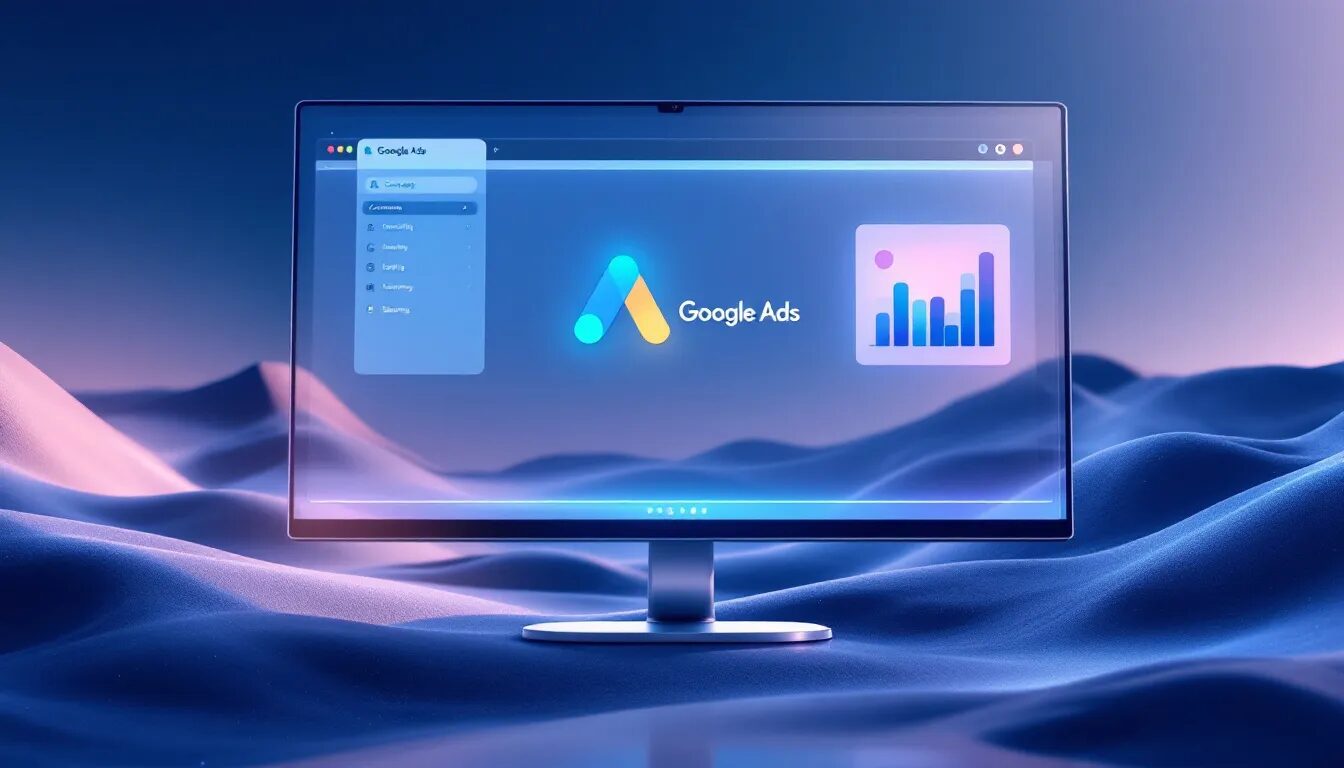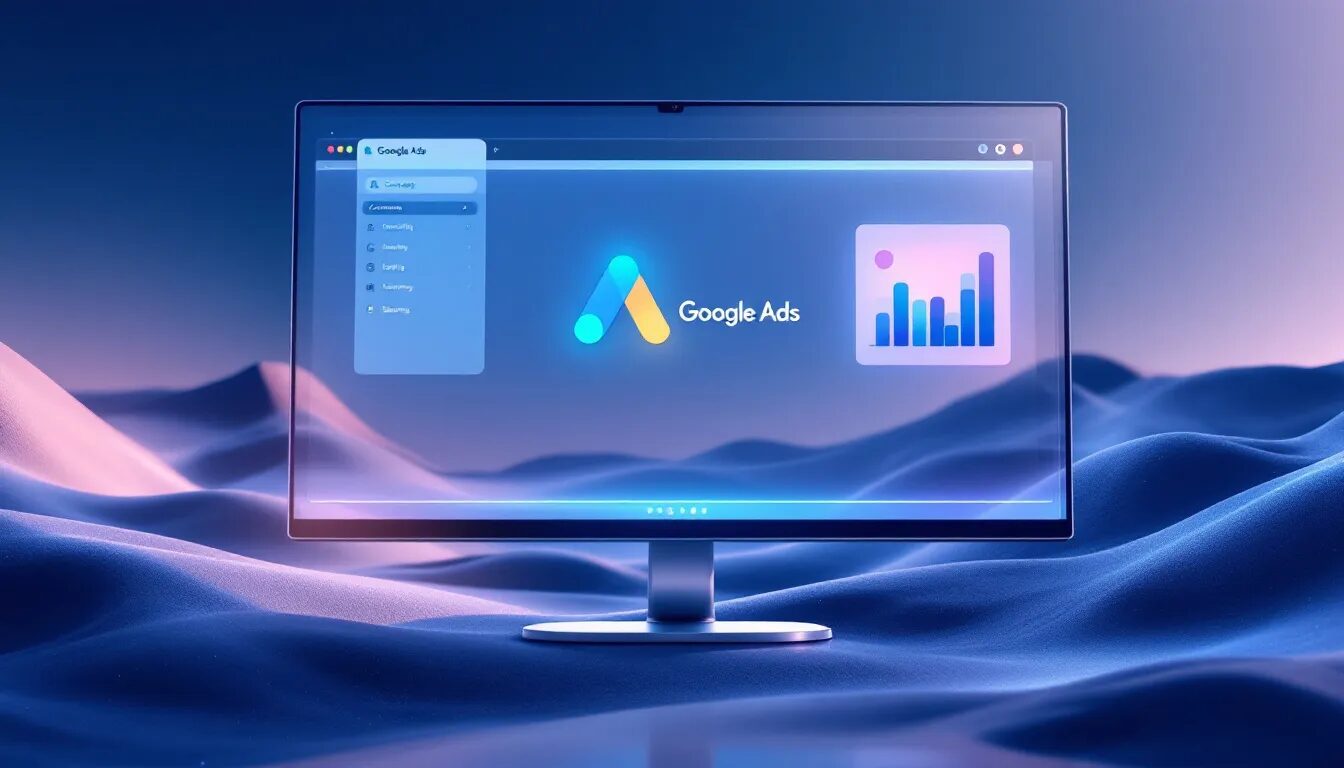
Master Google Ads: A Guide to Effective Online Advertising
Google Ads helps you attract new customers with targeted online ads. This guide will help you set up, manage, and optimize your campaigns for better results.
Key Takeaways
-
Starting with Google Ads requires setting up a dedicated account and defining your advertising goals to structure effective campaigns.
-
Ongoing optimization is crucial, involving regular analysis of performance metrics, keyword selection, and ad copy adjustments to improve campaign effectiveness.
-
Leveraging advanced features like Performance Max campaigns and audience targeting can significantly enhance ad performance and reach specific demographics.
Getting Started with Google Ads

Starting with Google Ads involves setting up a Google account and defining your advertising goals. A dedicated Google account for ads management enhances trust and provides access to additional features. After setting up your account, clearly define your advertising objectives. Whether you aim to drive traffic to your website, increase sales, or boost brand awareness, setting clear goals will guide your campaign setup and ensure you stay focused on your targets.
Launching your first Google Ads campaign involves careful planning. Select your primary advertising objective, add advertising assets, and set up billing information. These foundational steps ensure your campaigns are structured effectively and ready for success.
Setting Up Your Google Account
Kickstart your Google Ads journey by creating a Google account. Visit the Google account creation page and enter your personal information, such as your name, email address, and password.
Verifying your Google Ads account enhances trust and grants access to additional features. A verified account allows you to fully utilize all tools available for effective ads management.
Creating Your First Campaign
Creating your first Google Ads campaign starts with selecting your advertising objective. This step determines the direction and setup of your campaign. Choosing the right objective, whether it’s driving traffic, increasing sales, or boosting brand awareness, is key to your campaign’s success.
With your objective set, focus on adding advertising assets and setting up billing information to launch your campaign.
Understanding Campaign Types
Google Ads offers various campaign types tailored to different advertising goals, including search, display, and video campaigns. Understanding these types is crucial as it determines where your ads will appear and how they will engage your target audience.
Whether focusing on search ads that appear in Google search results or display ads that enhance brand visibility across websites and apps, selecting the right campaign type is essential for maximizing your advertising efforts.
Optimizing Your Google Ads Campaigns

Optimization is an ongoing process requiring frequent analysis and adjustments based on performance metrics. Regularly updating keywords, ad copy, and targeting strategies is essential for maintaining the effectiveness of your Google Ads campaigns. This includes testing different ad copies, adjusting bidding strategies, and using long-tail keywords to attract more qualified traffic. Automated recommendations can also optimize campaigns by auto-applying changes to improve performance.
Effective budget management is another key aspect of optimization. Regularly analyzing and adjusting your bids can lead to better ad placement and improved returns. Automated bidding strategies can help optimize your ad spend based on performance data. Continuously refining your campaigns ensures they remain effective and aligned with your advertising goals.
Keyword Research and Selection
Keyword research is fundamental to reaching the right audience with your ads. Tools like Keyword Planner can help identify relevant keywords based on your business offerings. Avoid overly specific keywords that might limit search relevance.
Effective keyword selection improves campaign visibility and performance, ensuring your ads appear to users actively searching for related products or services.
Ad Copy Best Practices
Crafting compelling ad copy is essential for attracting clicks and driving conversions. A clear call to action can significantly enhance click-through rates. Highlighting unique selling propositions differentiates your offerings from competitors and makes your ads more appealing.
Incorporating at least one responsive search ad with ‘Good’ or ‘Excellent’ Ad Strength can significantly increase conversions.
Budget Management
Effective budget management is vital for optimizing your Google Ads campaigns. Setting up a campaign involves selecting a primary goal, adding advertising assets, and confirming payment details. Regularly reviewing and adjusting bids based on campaign performance helps optimize budget allocation.
Monitoring campaign performance allows for reallocating the budget to the best-performing campaigns and ad groups, ensuring a better ROI.
Advanced Features and Strategies
Exploring advanced features in Google Ads can significantly enhance campaign effectiveness and reach. Utilizing AI tools within Google Ads can drive better results by optimizing campaigns efficiently. Performance Max campaigns, which unify multiple advertising channels into a single campaign, are particularly effective in enhancing reach and performance. Advanced strategies include integrating various asset types in display ads to make them more engaging and meet diverse marketing objectives.
Conversion tracking and analytics are key components of advanced Google Ads strategies. Tracking conversions from multiple sources, such as website interactions, app downloads, and offline actions, provides a comprehensive view of campaign performance. Audience targeting and segmentation allow advertisers to tailor messaging to specific demographics, interests, and behaviors, enhancing ad relevance and effectiveness.
Performance Max Campaigns
Performance Max campaigns allow advertisers to access multiple Google platforms, including Search, Display, YouTube, and Gmail, to maximize ad performance. These campaigns use machine learning to optimize bids and placements in real-time based on specified conversion goals.
Consolidating various advertising channels into a single campaign, Performance Max ensures a streamlined and efficient approach to reaching target audiences.
Conversion Tracking and Analytics
Google Ads supports tracking conversions from various sources, providing a comprehensive view of performance. Tracking specific actions like purchases and form submissions helps assess campaign effectiveness. Data-driven attribution allows marketers to identify which ad interactions lead to conversions, enabling more informed strategy adjustments.
Using insights from Google Analytics alongside Google Ads data enhances strategy adjustments based on user behavior.
Audience Targeting and Segmentation
Audience segmentation in Google Ads allows advertisers to tailor messaging to specific demographics, interests, and behaviors. Google Ads provides various audience segments, enabling advertisers to reach users based on interests, behaviors, and demographics.
Custom audiences can be created based on user interests and behaviors, allowing for personalized ad messaging. Incorporating audience signals helps Google Ads identify and reach potential customers effectively.
Leveraging Different Ad Formats

Google Ads offers various ad formats, each designed to achieve specific advertising goals. These include search, display, and video ads, which cater to different campaign types and marketing objectives. Responsive display ads, for example, allow advertisers to provide images, headlines, and descriptions, which Google then optimizes for performance across various sites and apps.
Improving ad relevance by incorporating user-focused benefits can enhance the effectiveness of Google Ads campaigns. Using long-tail keywords can improve ad relevance and attract a more targeted audience. Leveraging different ad formats allows advertisers to create more engaging and effective campaigns that resonate with target audiences and drive better results.
Search Ads
Search ads target users actively looking for specific products or services, making them essential for advertisers. Text ads in search campaigns allow rapid maintenance and are effective for reaching users actively seeking products or services.
These ads enable advertisers to engage directly with potential customers at the moment they express intent, ensuring quick and efficient connections.
Display Ads
Display ads are visually appealing advertisements that appear on websites and apps, helping to increase brand visibility and engagement. Image ads can be static or animated, offering visual engagement and serving ads on websites that partner with Google.
High-quality images significantly improve the performance of display ads by attracting user attention and increasing click-through rates.
Video Ads
Video ads on platforms like YouTube boost brand visibility and often lead to higher engagement rates than static videos. They leverage storytelling and engaging visuals to connect with audiences emotionally.
Video ads can be integrated into streaming content or run as standalone, providing a rich experience that enhances audience engagement. Compelling visuals and narratives in video ads can enhance viewer retention and brand recall.
Industry-Specific Strategies

Tailoring ad strategies to specific industries can significantly enhance the effectiveness of Google Ads campaigns. Different industries require unique strategies to utilize Google Ads effectively, enhancing overall ad performance. For instance, e-commerce businesses might focus on promoting inventory through Google Shopping ads, while service-based businesses could leverage local targeting and ad scheduling to reach potential clients.
Each campaign type in Google Ads has unique best practices and setups tailored to specific advertising goals. Industry-specific strategies ensure campaigns are aligned with the unique needs and objectives of different sectors, maximizing their potential to drive sales, generate leads, or build brand awareness.
E-commerce and Retail
Utilizing Google Shopping ads is essential for e-commerce, as they display products directly in search results, enhancing visibility. Promoting inventory effectively is crucial for e-commerce businesses to increase visibility and drive sales.
Detailed and optimized product listings with quality images and persuasive descriptions can maximize sales through Google Shopping ads.
Service-Based Businesses
Specific targeting strategies in Google Ads can significantly increase lead generation for service-based businesses. Ad scheduling can optimize service ads by displaying them during peak times when potential customers are most likely to seek services.
Call extensions can enhance service ads by allowing potential clients to call directly from the search results. Effective lead generation strategies are crucial for service-based businesses to attract new customers and increase bookings.
Mobile App Promotion
App install ads can effectively drive downloads, particularly when combined with targeted audience segments based on user behavior. Re-engagement campaigns are essential for mobile apps, encouraging users who have previously installed the app to return and interact with it again.
Retargeting users who have previously engaged with the app can significantly boost reinstall rates and user retention. Combining app install ads with effective re-engagement and retargeting strategies creates a comprehensive marketing approach that maximizes user acquisition and retention.
Staying Compliant with Google Ads Policies
Compliance with Google Ads policies is critical to maintaining a trustworthy advertising environment. These policies are designed to create a safe space for users, advertisers, and publishers by prohibiting harmful and misleading content. Google implements a review process that combines AI and human evaluations to enforce these policies effectively, ensuring that ads meet the required standards. Adhering to these guidelines not only helps in maintaining ad performance but also avoids penalties that could negatively impact your campaigns.
To stay compliant, advertisers must be aware of content restrictions, trademark and legal considerations, and privacy and consent regulations. Understanding these aspects will help you create ads that are not only effective but also aligned with Google’s policies.
Content Restrictions
Google Ads prohibits misleading content that can deceive users or misrepresent the products being advertised. Content restrictions ensure that advertisements are honest and do not mislead users. Google has implemented a ‘Limited Ads Serving’ policy to protect users by restricting ad impressions for new advertisers without established credibility.
Advertiser are also not allowed to use content that promotes dangerous products or services, ensuring user safety. Adherence to these guidelines is essential for maintaining ad performance and avoiding penalties.
Trademark and Legal Considerations
Advertisers must comply with Google’s trademark policies, which prohibit the use of trademarked terms in ads unless authorized. This means ensuring that ad copy and keywords do not infringe on trademarks, which requires explicit authorization from the trademark owner.
To promote products legally, advertisers must adhere to local laws and obtain necessary certifications when using trademarks in their ads. This compliance helps maintain the integrity and support of advertising campaigns.
Privacy and Consent
Google’s Consent Mode supports compliance with privacy regulations by allowing advertisers to customize data collection practices based on user consent. This feature enhances privacy compliance by modifying cookie usage according to the consent status of users. Implementing effective data collection practices is crucial for complying with privacy laws and maintaining user trust.
Google’s policies require advertisers to handle user information responsibly and transparently, providing clear disclosures regarding data collection methods.
Measuring Success and Adjusting Strategies
To measure the success of Google Ads campaigns, defining clear objectives and utilizing metrics that align with those goals is crucial. Tracking specific metrics and adjusting strategies accordingly helps in evaluating campaign effectiveness. This involves ongoing monitoring and analysis to adapt and enhance performance. By regularly evaluating the effectiveness of your campaigns, you can identify areas for improvement and make data-driven decisions that optimize your advertising efforts.
Key performance indicators (KPIs) such as click-through rate (CTR), conversion rate, and cost per click (CPC) are essential in assessing campaign performance. Data analysis helps identify high-performing areas, enabling advertisers to replicate success in other areas.
Continuous optimization through iterative changes based on feedback and performance data ensures that campaigns remain effective and aligned with advertising goals.
Key Performance Indicators (KPIs)
Common KPIs for Google Ads include click-through rate (CTR), conversion rate, and cost per click (CPC), which help assess campaign performance. Additionally, cost per acquisition (CPA) and return on ad spend (ROAS) are critical metrics that provide insight into campaign efficiency and effectiveness.
By regularly monitoring these KPIs, advertisers can make informed adjustments to their strategies to enhance campaign performance.
Data-Driven Decisions
Analyzing data from campaigns enables advertisers to identify high-performing areas and adjust strategies accordingly for better results. Understanding where campaigns are succeeding allows advertisers to replicate success in other areas.
Utilizing insights gained from data analysis helps refine and optimize strategies, leading to improved ROI and successful campaign outcomes.
Continuous Optimization
Continuous optimization involves regularly reviewing conversion data to optimize campaigns based on measurable outcomes. Conducting A/B testing helps determine the most effective ads and audience segments for continual improvement.
Implementing iterative changes based on feedback and performance data ensures campaigns adapt and enhance effectiveness. Utilizing analytics tools allows advertisers to identify trends and patterns in campaign performance, informing strategic adjustments.
Summary
Mastering Google Ads involves a blend of strategic planning, continuous optimization, and compliance with policies. From setting up your Google account and creating your first campaign to leveraging advanced features and ad formats, each step is crucial for achieving your advertising goals. Regularly optimizing your campaigns by refining keywords, ad copy, and budget management ensures they remain effective and aligned with your objectives.
Tailoring strategies to specific industries, staying compliant with Google Ads policies, and measuring success through key performance indicators are essential for maximizing the potential of your campaigns. By applying the knowledge and strategies discussed in this guide, you can grow your business effectively and achieve great results with Google Ads.
Frequently Asked Questions
How do I get started with Google Ads?
To get started with Google Ads, create a dedicated Google account for ads management, define your advertising goals, and launch your first campaign by selecting your main objective and setting up billing information. This structured approach will help you navigate the platform effectively.
What are the different types of Google Ads campaigns?
Google Ads includes several campaign types, namely search, display, and video campaigns, each tailored to meet distinct advertising goals. Choosing the right type is essential for effective targeting and engagement.
How can I optimize my Google Ads campaigns?
To optimize your Google Ads campaigns, regularly update keywords and ad copy, utilize automated recommendations, and analyze performance metrics for informed adjustments. These practices will help you enhance campaign effectiveness and drive better results.
What are Performance Max campaigns?
Performance Max campaigns integrate various Google platforms into a single campaign, leveraging machine learning to optimize bids and placements in real-time according to your conversion goals. This approach enhances efficiency and effectiveness in reaching desired outcomes.
How can I ensure my ads comply with Google Ads policies?
To ensure your ads comply with Google Ads policies, follow content restrictions, respect trademarks and legal considerations, and uphold privacy regulations. This will help you maintain a trustworthy advertising environment and avoid potential penalties.
© 2025, Vertical Response. All rights reserved.



